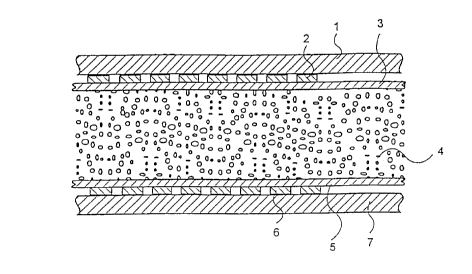Note: Claims are shown in the official language in which they were submitted.
-7-
claims
1. A method for producing injection-molded cards with at least one decorative
layer (2, 6, 12, 14), the decorative layer being applied to a carrier layer
(1, 7,
13), characterized in that
- the decorative layer (2, 6, 12, 14) is covered with a protective layer (3,
5,
11, 15),
- the thus coated carrier layer (1, 7, 13) is inserted into an injection mold
in
such a way that the protective layer (3, 5, 11, 15) does not lie against the
wall of the injection mold,
- the injection mold is closed and the injection molding compound (4, 10,
16) is injected into the injection mold, and
- the injection-molded card is removed from the injection mold.
2. A method according to claim 1, characterized in that the protective layer
(3, 5,
1l, 15) consists of a material which increases the adhesion of the injection
molding material (4, 10, 16) to the carrier layer (1, 7, 13).
3. A method according to claim 1 or 2, characterized in that the protective
layer
(3, 5, 11, 15) contains pigments or dyes.
4. A method according to any of claims 1 to 3, characterized in that feature
substances for authenticity testing are incorporated in the protective layer
(3, 5, 11,
15).
5. A method according to any of claims 1 to 4, characterized in that at least
one
lacquer layer is applied to the decorative layer (2, 6, 12, 14) as a
protective
layer (3, 5, 11, 15).
6. A method according to any of claims 1 to 5, characterized in that a foil is
applied to the decorative layer (2, 6, 12, 14) as a protective layer (3, 5,
11, 15).
7. A method according to any of claims 1 to 6, characterized in that the
carrier
layer (1, 7) consists of a transparent foil which is inserted into an
injection
mold in such a way that the uncoated side of the transparent foil (1, 7) lies
against the wall of the injection mold.
-8-
8. A method according to claim 7, characterized in that the coated foil ( l,
7) has a
gap into which a chip module (8) is inserted.
9. A method according to any of claims 1 to 6, characterized in that
- the carrier layer (13) is formed as a card inlay,
- the decorative layer (12, 14) is covered with a transparent protective layer
(11, 15), and
- the thus coated card inlay (13) is inserted into the injection mold in such
a
way that at least one main face of the card inlay (13) does not lie against
the wall of the injection mold.
10. An injection-molded card consisting of an injection-molded body (4, 10,
16)
and at least one carrier layer (1, 7, 13) to which a decorative layer (2, 6,
12, 14)
is applied, characterized in that the decorative layer (2, 6, 12, 14) is
covered
with a protective layer (3, 5, 11, 15), and the carrier layer (1, 7, 13) is
disposed
on the injection-molded body (4, 10, 16) in such a way that the protective
layer
is directly adjacent to the injection-molded body.
11. An injection-molded card according to claim 10, characterized in that the
car-
rier layer ( 1, 7) consists of transparent material which is disposed on one
or
both main faces of the injection-molded body (4).
12. An injection-molded card according to claim 10, characterized in that the
car-
rier layer (13) is formed as a card inlay which is provided on one or both
sides
with a decorative layer and wherein the injection-molded body ( 10, 16) is
transparent.
